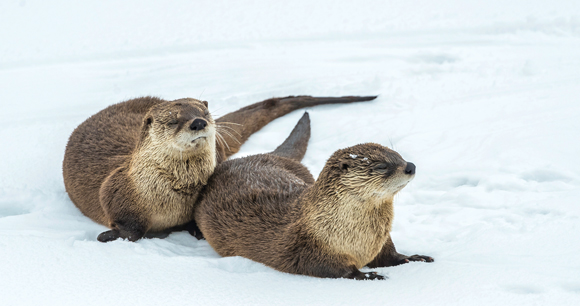Keeping “Track” of Northern River Otters
The live capture of river otters is notoriously difficult, which explains the dearth of information about the ecology of the species. Traditional traps, including leghold and cage traps, can be used to capture otters for research, but they can result in injuries and stress to the animal. In addition, many traps set for otters can capture nontarget species.

What if a method could be found that would negate the need to trap otters for research purposes? With support from an AWI Christine Stevens Wildlife Award, a novel and noninvasive method for sampling river otters using DNA collected from otter tracks left in the snow was tested in the western part of Michigan’s Upper Peninsula. The study sought to determine if there was enough nuclear DNA in snow tracks to identify individual otters and assess what factors influenced the ability to acquire DNA from tracks.
Between January and April 2019, otter tracks in the snow were collected and placed in individual sample bags. Snow samples without otter tracks were also collected to use as a control. In the laboratory, the snow was melted and filtered. Then nuclear DNA was extracted and amplified using a quantitative polymerase chain reaction protocol, or qPCR. (PCR involves copying, or “amplifying” small pieces of DNA to create sufficient quantities for genetic analyses; qPCR is a method for detecting results during the early phases of the reaction, when more precise measurements can be made.)
The 87 tracks collected resulted in 159 filters potentially containing DNA. Out of the 159 filters, DNA was found in 94 (66%). The ability to find DNA in track samples was positively correlated, predictably, with the number of track samples collected but negatively correlated with the number of days the samples were stored in a freezer.
Age of the track, snow sample volume, and temperature did not appear to affect DNA collection. We were able to identify multiple genetic markers (microsatellites) in the DNA from the snow samples and are continuing analyses to determine if enough genetic markers were amplified in each sample to differentiate individual otters.
If successful, the DNA results obtained from this pilot study, along with additional sampling, will be used to estimate population numbers using mark and recapture techniques, evaluate genetic diversity, and measure the gene flow of otters in the western Upper Peninsula of Michigan. The methods developed in this project would potentially work for genetic and mark-recapture studies from the tracks of other wildlife species living in areas with snow. Otter tracks are easy to detect, and collecting them causes the animal little, if any, stress—especially when compared with traditional mark-recapture methods, in which an animal is physically captured and recaptured using traps. Identifying individuals from tracks could inform scientists about population demographics, habitat use, movement behavior, dispersal patterns, genetic diversity, and gene flow—not only for otter populations but also for many other elusive species with large home ranges.
This study was funded by the Christine Stevens Wildlife Awards program. Learn more about this program or to view additional studies.
Program Terms: Terrestrial Wildlife
AWI Quarterly Terms: Feature Article
Related News
IUCN Reaffirms Long-Tailed Macaques’ Endangered Status Despite Industry Pressure
In Program: Terrestrial WildlifeThe International Union for Conservation of Nature (IUCN) today released an update to its Red List of Threatened Species. The update revealed that the long-tailed...
AWI Funds Research to Alleviate Human-Wildlife Conflicts, Animal Suffering
In Program: Terrestrial WildlifeThe Animal Welfare Institute (AWI) announced today the eight recipients of its Christine Stevens Wildlife Award who are developing humane solutions to human-wildlife conflicts and...
Refuge from Cruel Trapping Act Reintroduced to Protect Wildlife and Pets on Public Lands
In Program: Companion Animals, Terrestrial WildlifeThe Animal Welfare Institute (AWI) endorses the Refuge from Cruel Trapping Act, reintroduced today in the US House of Representatives by Rep. Jerrold Nadler (D-NY)....
Colorado Now Leads Country in Comprehensive Approach to Fighting Wildlife Trafficking
In Program: Terrestrial WildlifeToday, Colorado Gov. Jared Polis signed S.B. 25-168 into law to combat wildlife trafficking. The bipartisan legislation, which is unique among states for the number...